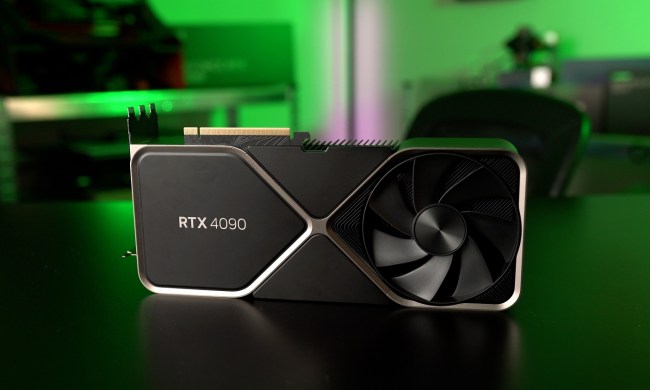Nvidia is reportedly sending individuals in the press to a special event around the time Germany’s Gamescom convention kicks off on August 21. That means the company may reveal the GTX 11 Series at that time given Nvidia is no longer listed for talks during the Hot Chips symposium. Micron recently officially launched volume production of GDDR6 memory, possibly giving Nvidia the green light to move forward with its launch plans.
More hints that Nvidia may be ready to announce its next-generation graphics cards at around the time of Gamescom have recently surfaced. A photo that has since been removed on Reddit shows a prototype board without the actual GPU mounted. The board contains three eight-pin power connections, 12 modules of Micron’s GDDR6 memory, and a component that looks like it could be used for Nvidia’s NVLink, according to Videocardz. Additionally, a PC parts retailer in Vietnam is jumping the gun, taking pre-orders for ASUS- and MSI-branded boards of the GTX1180, Gizmodo reported, suggesting that the GPU announcement could happen soon. Given the current conversion rates, the boards would retail for $1,400, but the pre-order pages have been taken down, according to PCGamesN.
Behind the scenes, third-party graphics card manufacturers will receive Nvidia’s next-generation “Turing” chips by the end of August or early September, sources tell Wccftech. Actual ship dates are unknown for now as manufacturers could take weeks or several months after receiving their initial GPU shipments to get GTX 11 Series product out on the market. But if problems arise related to using Nvidia’s new architecture, volume shipments may not happen until the first quarter of 2019.
A Lenovo representative all but confirmed the branding Nvidia will use with its next-generation GPUs in a recent on-camera interview. While talking about the company’s Legion 730 Series desktop PCs for gaming, he said that at launch they would sport up to a GTX 1060 and eventually up to a GTX 1180 when the GTX 11 Series hit the streets. Later on, he talked about the Legion 530 Cube series and said they would support the GTX 11 Series later this fall.
Detailed specifications of Nvidia’s rumored GTX 1180 have already appeared online in the TechPowerUp GPU database, giving us an in-depth look at the capabilities of the upcoming card. The listing is likely an engineering sample, and therefore subject to change by the time consumer hardware is released, but this gives us our best idea yet of just how powerful the card might be.
Nvidia has expanded its lineup slowly but steadily over the years; the last time it debuted a new graphics card range was the Pascal lineup in 2016. It’s been rather successful, despite problems with pricing and availability over the past year. But progress marches forward and we expect Nvidia’s next generation to debut in the coming months, with the GTX 1180 at its head.
We’ve already seen hints of the “Volta” generation with the Titan V enterprise card, but consumers will be looking for something more affordable and down to earth. Although it may debut under the “Turing” banner, the GTX 1180 will be a top-tier graphics card when released and is likely to be much more affordable (despite rumors to the contrary).
In the TechPowerUp database listing, the GTX 1180 is said to be based on the GV104 graphics chip, which is built on a 12nm process. It features 3,584 shader units and 224 texture mapping units — a noticeable increase over the GTX 1080’s 2,560 and 160 respectively. The core clock is said to be 1,405MHz at idle, boosting to 1,582MHz as required, though as enthusiast site Wccftech highlights, clock speeds are the most likely aspect of this graphics card to change by its release, especially when you consider third-party overclocked versions.
In terms of memory, the GTX 1180 reportedly sports a little more than 16GB of GGDR6, the newest generation of graphics memory. With a claimed memory clock of 1,500MHz (12,000 MHz effective), it delivers a bandwidth of 384 GBps. That is 64 more than the GTX 1080.
The GTX 1180 should also be appealing to gamers. An earlier leak suggests that it will support 4K gaming with a 144Hz refresh rate.
One of the most impressive aspects of this card is its power draw. It’s said to require just 200 watts — more than the GTX 1080, yet significantly less than AMD’s last top-end cards, the Vega 56 and 64, which pull upward of 300w in some settings.
Updated on July 2: Added information about a photo of a prototype board that has since been deleted, and pre-order information from a parts retailer in Vietnam.




